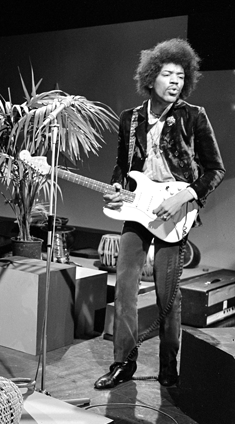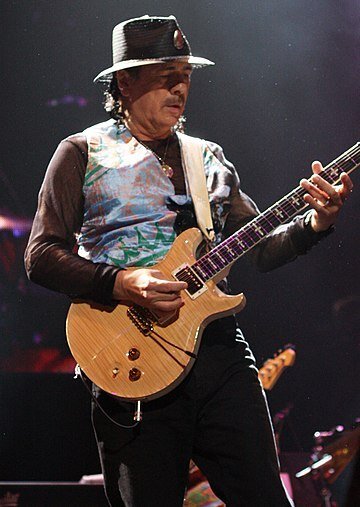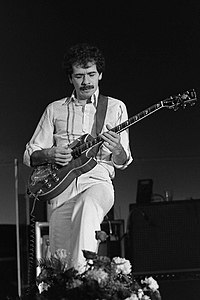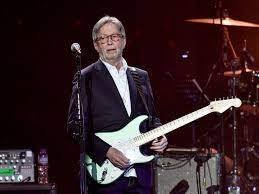GUITAR GREATS HEROS
Guitar Heros
Jimi Hendrix
James Marshall "Jimi" Hendrix (born Johnny Allen Hendrix; November 27, 1942 – September 18, 1970) was an American guitarist, singer, and songwriter. Although his mainstream career spanned only four years, he is widely regarded as one of the most influential electric guitarists in the history of popular music, and one of the most celebrated musicians of the 20th century. The Rock and Roll Hall of Fame describes him as "arguably the greatest instrumentalist in the history of rock music".

Born in Seattle, Washington, Hendrix began playing guitar at the age of 15. In 1961, he enlisted in the US Army, but was discharged the following year. Soon afterward, he moved to Clarksville then Nashville, Tennessee, and began playing gigs on the chitlin' circuit, earning a place in the Isley Brothers' backing band and later with Little Richard, with whom he continued to work through mid-1965. He then played with Curtis Knight and the Squires before moving to England in late 1966 after bassist Chas Chandler of the Animals became his manager. Within months, Hendrix had earned three UK top ten hits with the Jimi Hendrix Experience: "Hey Joe", "Purple Haze", and "The Wind Cries Mary". He achieved fame in the US after his performance at the Monterey Pop Festival in 1967, and in 1968 his third and final studio album, Electric Ladyland, reached number one in the US. The double LP was Hendrix's most commercially successful release and his first and only number one album. The world's highest-paid performer, he headlined the Woodstock Festival in 1969 and the Isle of Wight Festival in 1970 before his accidental death in London from barbiturate-related asphyxia on September 18, 1970.
Hendrix was inspired by American rock and roll and electric blues. He favored overdriven amplifiers with high volume and gain, and was instrumental in popularizing the previously undesirable sounds caused by guitar amplifier feedback. He was also one of the first guitarists to make extensive use of tone-altering effects units in mainstream rock, such as fuzz distortion, Octavia, wah-wah, and Uni-Vibe. He was the first musician to use stereophonic phasing effects in recordings. Holly George-Warren of Rolling Stone commented: "Hendrix pioneered the use of the instrument as an electronic sound source. Players before him had experimented with feedback and distortion, but Hendrix turned those effects and others into a controlled, fluid vocabulary every bit as personal as the blues with which he began."
Hendrix was the recipient of several music awards during his lifetime and posthumously. In 1967, readers of Melody Maker voted him the Pop Musician of the Year and in 1968, Billboard named him the Artist of the Year and Rolling Stone declared him the Performer of the Year. Disc and Music Echo honored him with the World Top Musician of 1969 and in 1970, Guitar Player named him the Rock Guitarist of the Year. The Jimi Hendrix Experience was inducted into the Rock and Roll Hall of Fame in 1992 and the UK Music Hall of Fame in 2005. Rolling Stone ranked the band's three studio albums, Are You Experienced, Axis: Bold as Love, and Electric Ladyland, among the 100 greatest albums of all time, and they ranked Hendrix as the greatest guitarist and the sixth greatest artist of all time.
Carlos Santana
Carlos Augusto Santana Alves (Spanish);
Born July 20, 1947) is an American guitarist who rose to fame in the late 1960s and early 1970s with his band Santana, which pioneered a fusion of Rock and roll and Latin American jazz. Its sound featured his melodic, blues-based lines set against Latin American and African rhythms played on percussion instruments not generally heard in rock, such as timbales and congas. He experienced a resurgence of popularity and critical acclaim in the late 1990s. In 2015, Rolling Stone magazine listed him at No. 20 on their list of the 100 greatest guitarists.[2] He has won 10 Grammy Awards and three Latin Grammy Awards,[3] and was inducted along with his namesake band into the Rock and Roll Hall of Fame in 1998.

Record deal, Woodstock breakthrough, and height of success: 1969–1972
 Santana's band was signed by Columbia Records, which shortened its name to simply "Santana". It went into the studio to record its first album in January 1969, finally laying down tracks in May that became its first album.
Santana's band was signed by Columbia Records, which shortened its name to simply "Santana". It went into the studio to record its first album in January 1969, finally laying down tracks in May that became its first album.Members were not satisfied with the release, dismissed drummer Bob Livingston, and added Mike Shrieve, who had a strong background in both jazz and rock. The band then lost percussionist Marcus Malone, who was charged with involuntary manslaughter. Michael Carabello was re-enlisted in his place, bringing with him experienced Nicaraguan percussionist José Chepito Areas.
Major rock music promoter Bill Graham, a Latin Music aficionado who had been a fan of Santana from its inception, arranged for the band to appear at the Woodstock Music and Art Festival before its debut album was even released. Its set was one of the surprises of the festival, highlighted by an eleven-minute performance of a throbbing instrumental, "Soul Sacrifice".
Its inclusion in the Woodstock film and soundtrack album vastly increased the band's popularity. Graham also suggested Santana record the Willie Bobo song "Evil Ways", as he felt it would get radio airplay. The band's first album, Santana, was released in August 1969 and became a hit, reaching No. 4 on the U.S. Billboard 200.
Caravanserai

Santana performing in Hamburg, Germany in 1973
In early 1972, Santana and the remaining members of the band started working on their fourth album, Caravanserai. During the studio sessions, Santana and Michael Shrieve brought in other musicians: percussionists James Mingo Lewis and Latin-Jazz veteran, Armando Peraza replacing Michael Carabello, and bassists Tom Rutley and Doug Rauch replacing David Brown. Also assisting on keyboards were Wendy Haas and Tom Coster. With the unsettling influx of new players in the studio, Gregg Rolie and Neal Schon decided that it was time to leave after the completion of the album, even though both contributed to the session. Rolie returned home to Seattle; later, he and Schon became founding members of Journey.
When Caravanserai did emerge in 1972, it marked a strong change in musical direction towards jazz fusion. The album received critical praise, but CBS executive Clive Davis warned Santana and the band that it would sabotage the band's position as a "Top 40" act. Nevertheless, over the years, the album achieved platinum status. The difficulties Santana and the band went through during this period were chronicled in Ben Fong-Torres' Rolling Stone 1972 cover story "The Resurrection of Carlos Santana".
Shifting styles and spirituality: 1972–1979
 New Year's Eve 1976 at the Cow Palace in San Francisco.
New Year's Eve 1976 at the Cow Palace in San Francisco.In 1972, Santana became interested in the pioneering fusion band the Mahavishnu Orchestra and its guitarist, John McLaughlin. Aware of Santana's interest in meditation, McLaughlin introduced Santana and his wife Deborah to his guru Sri Chinmoy.
Chinmoy accepted them as disciples in 1973. Santana was given the name Devadip, meaning "The lamp, light and eye of God". Santana and McLaughlin recorded an album together, Love, Devotion, Surrender (1973) with members of Santana and the Mahavishnu Orchestra, along with percussionist Don Alias and organist Larry Young, both of whom had made appearances, along with McLaughlin, on Miles Davis' classic 1970 album Bitches Brew.
In 1973, Santana, having obtained legal rights to the band's name, Santana, formed a new version of the band with Armando Peraza and Chepito Areas on percussion, Doug Rauch on bass, Michael Shrieve on drums, and Tom Coster and Richard Kermode on keyboards. Santana later was able to recruit jazz vocalist Leon Thomas for the tour supporting Caravanserai in Japan on July 3 and 4, 1973, which was recorded for the 1974 live, sprawling, high-energy triple vinyl LP fusion album Lotus. CBS records would not allow its release unless the material was condensed. Santana did not agree to those terms, and Lotus was available in the U.S. only as an expensive, imported, three-record set. The group later went into the studio and recorded Welcome (1973), which further reflected Santana's interests in jazz fusion and his increasing commitment to the spiritual life of Sri Chinmoy.
A collaboration with John Coltrane's widow, Alice Coltrane, Illuminations (1974), followed. The album delved into avant-garde esoteric free jazz, Eastern Indian and classical influences with other ex-Miles Davis sidemen Jack DeJohnette and Dave Holland. Soon after, Santana replaced his band members again.
This time Kermode, Thomas and Rauch departed from the group and were replaced by vocalist Leon Patillo (later a successful Contemporary Christian artist) and returning bassist David Brown. He also recruited soprano saxophonist, Jules Broussard for the lineup. The band recorded one studio album Borboletta, which was released in 1974. Drummer Leon "Ndugu" Chancler later joined the band as a replacement for Michael Shrieve, who left to pursue a solo career.
 Santana during his European tour in the Netherlands in 1978
Santana during his European tour in the Netherlands in 1978By this time, Bill Graham's management company had assumed responsibility for the affairs of the group. Graham was critical of Santana's move into jazz and felt he needed to concentrate on getting Santana back into the charts with the edgy, streetwise ethnic sound that had made them famous. Santana himself was seeing that the group's direction was alienating many fans. Although the albums and performances were given good reviews by critics in jazz and jazz fusion circles, sales had plummeted.
Santana, along with Tom Coster, producer David Rubinson, and Chancler, formed yet another version of Santana, adding vocalist Greg Walker. The 1976 album Amigos, which featured the songs "Dance, Sister, Dance" and "Let It Shine", had a strong funk and Latin sound. The album received considerable airplay on FM album-oriented rock stations with the instrumental "Europa (Earth's Cry Heaven's Smile)" and re-introduced Santana to the charts. In 1976, Rolling Stone ran a second cover story on Santana entitled "Santana Comes Home". In February 1976, Santana was presented with fifteen gold disc in Australia, representing sales in excess of 244,000.
The albums conceived through the late 1970s followed the same formula, although with several lineup changes. Among the new personnel who joined was current percussionist Raul Rekow, who joined in early 1977. Most notable of the band's commercial efforts of this era was a version of the 1960s Zombies hit, "She's Not There", on the 1977 double album Moonflower.
Santana recorded two solo projects in this time: Oneness: Silver Dreams – Golden Reality, in 1979 and The Swing of Delight in 1980, which featured Herbie Hancock, Wayne Shorter, Ron Carter, and Tony Williams.
The pressures and temptations of being a high-profile rock musician and requirements of the spiritual lifestyle which guru Sri Chinmoy and his followers demanded were in conflict, and imposed considerable stress upon Santana's lifestyle and marriage. He was becoming increasingly disillusioned with what he thought were the unreasonable rules that Chinmoy imposed on his life, and in particular with his refusal to allow Santana and Deborah to start a family. He felt too that his fame was being used to increase the guru's visibility. Santana and Deborah eventually ended their relationship with Chinmoy in 1982.
1980s and early 1990s
 Santana in Barcelona, Spain, 1984
Santana in Barcelona, Spain, 1984 L to R: Bob Dylan, Joan Baez, and Santana in Hamburg, May 1984
L to R: Bob Dylan, Joan Baez, and Santana in Hamburg, May 1984More radio-friendly singles followed from Santana and the band. "Winning" in 1981 (from Zebop!) and "Hold On" (a remake of the Canadian artist Ian Thomas' song) in 1982 both reached the top twenty. After his break with Sri Chinmoy, Santana went into the studio to record another solo album with Keith Olson and legendary R&B producer Jerry Wexler.
The 1983 album Havana Moon revisited Santana's early musical experiences in Tijuana with Bo Diddley's "Who Do You Love" and the title cut, Chuck Berry's "Havana Moon". The album's guests included Booker T. Jones, the Fabulous Thunderbirds, Willie Nelson, and even Santana's father's mariachi orchestra. Santana again paid tribute to his early rock roots by doing the film score to La Bamba, which was based on the life of rock and roll legend Ritchie Valens and starred Lou Diamond Phillips.
The band Santana returned in 1985 with a new album, Beyond Appearances, and two years later with Freedom.
Growing weary of trying to appease record company executives with formulaic hit records, Santana took great pleasure in jamming and making guest appearances with notables such as the jazz fusion group Weather Report, jazz pianist McCoy Tyner, Blues legend John Lee Hooker, Frank Franklin, Living Colour guitarist Vernon Reid, and West African singer Salif Keita.
He and Mickey Hart of the Grateful Dead later recorded and performed with Nigerian drummer Babatunde Olatunji, who conceived one of Santana's famous 1960s drum jams, "Jingo". In 1988, Santana organized a reunion with past members from the Santana band for a series of concert dates. CBS records released a 20-year retrospective of the band's accomplishments with Viva Santana! double CD compilation.
That same year, Santana formed an all-instrumental group featuring jazz legend Wayne Shorter on tenor and soprano saxophone. The group also included Patrice Rushen on keyboards, Alphonso Johnson on bass, Armando Peraza and Chepito Areas on percussion, and Leon "Ndugu" Chancler on drums. They toured briefly and received much acclaim from the music press, who compared the effort with the era of Caravanserai (1972). Santana released another solo record, Blues for Salvador (1987), which won a Grammy Award for Best Rock Instrumental Performance.
In 1990, Santana left Columbia Records after twenty-two years and signed with Polygram. The following year he made a guest appearance on Ottmar Liebert's album, Solo Para Ti (1991), on the songs "Reaching out 2 U" and on a cover of his own song, "Samba Pa Ti". In 1992, Santana hired the jam band Phish as his opening act. On his 1992 tour, Santana regularly invited some or all of the members of Phish to jam with his band during his headlining performances. Phish also toured with Santana in Europe in 1996.
Eric Clapton
Eric Patrick Clapton CBE (born 30 March 1945) is an English rock and blues guitarist, singer, and songwriter. He is regarded as one of the most successful and influential guitarists in rock music.
Clapton ranked second in Rolling Stone's list of the "100 Greatest Guitarists of All Time"and fourth in Gibson's "Top 50 Guitarists of All Time". He was also named number five in Time magazine's list of "The 10 Best Electric Guitar Players" in 2009.
 After playing in a number of different local bands, Clapton joined the Yardbirds in 1963, replacing founding guitarist Top Topham. Dissatisfied with the change of the Yardbirds sound from blues rock to a more radio-friendly pop rock sound, Clapton left in 1965 to play with John Mayall & the Bluesbreakers. On leaving Mayall in 1966, after one album, he formed the power trio Cream with drummer Ginger Baker and bassist Jack Bruce, in which Clapton played sustained blues improvisations and "arty, blues-based psychedelic pop". After Cream broke up in November 1968, he formed the blues rock band Blind Faith with Baker, Steve Winwood, and Ric Grech, recording one album and performing on one tour before they broke up. Clapton embarked on a solo career in 1970.
After playing in a number of different local bands, Clapton joined the Yardbirds in 1963, replacing founding guitarist Top Topham. Dissatisfied with the change of the Yardbirds sound from blues rock to a more radio-friendly pop rock sound, Clapton left in 1965 to play with John Mayall & the Bluesbreakers. On leaving Mayall in 1966, after one album, he formed the power trio Cream with drummer Ginger Baker and bassist Jack Bruce, in which Clapton played sustained blues improvisations and "arty, blues-based psychedelic pop". After Cream broke up in November 1968, he formed the blues rock band Blind Faith with Baker, Steve Winwood, and Ric Grech, recording one album and performing on one tour before they broke up. Clapton embarked on a solo career in 1970.Alongside his solo career, he also performed with Delaney & Bonnie and Derek and the Dominos, with whom he recorded "Layla", one of his signature songs. He continued to record a number of successful solo albums and songs over the next several decades, including a 1974 cover of Bob Marley's "I Shot the Sheriff" (which helped reggae reach a mass market), the country-infused Slowhand album (1977) and the pop rock of 1986's August.
Following the death of his son Conor in 1991, Clapton's grief was expressed in the song "Tears in Heaven", which appeared on his Unplugged album, and in 1996 he had another top-40 hit with the R&B crossover "Change the World". In 1998, he released the Grammy award-winning "My Father's Eyes". Since 1999, he has recorded a number of traditional blues and blues rock albums and hosted the periodic Crossroads Guitar Festival. His most recent studio album is Happy Xmas (2018).
Clapton has received 18 Grammy Awards as well as the Brit Award for Outstanding Contribution to Music. In 2004, he was awarded a CBE for services to music. He has received four Ivor Novello Awards from the British Academy of Songwriters, Composers and Authors, including the Lifetime Achievement Award.
He is the only three-time inductee to the Rock and Roll Hall of Fame: once as a solo artist and separately as a member of the Yardbirds and of Cream. In his solo career, Clapton has sold more than 280 million records worldwide, making him one of the best-selling musicians of all time.[11] In 1998, Clapton, a recovering alcoholic and drug addict, founded the Crossroads Centre on Antigua, a medical facility for recovering substance abusers.